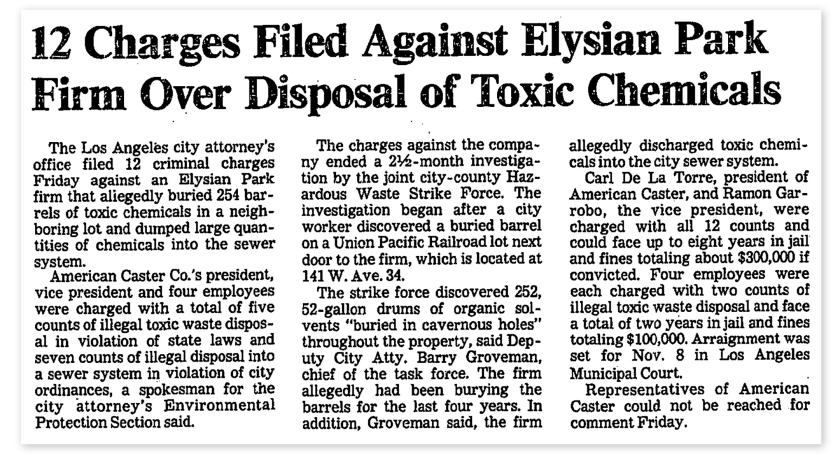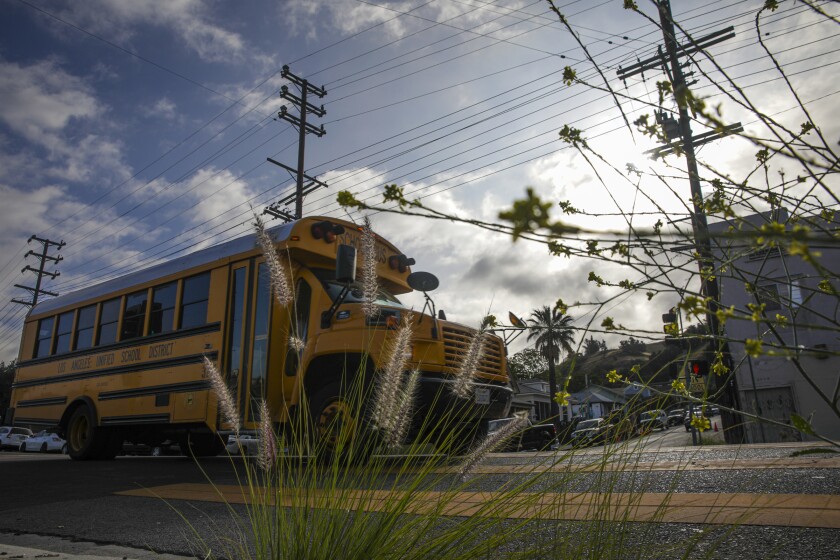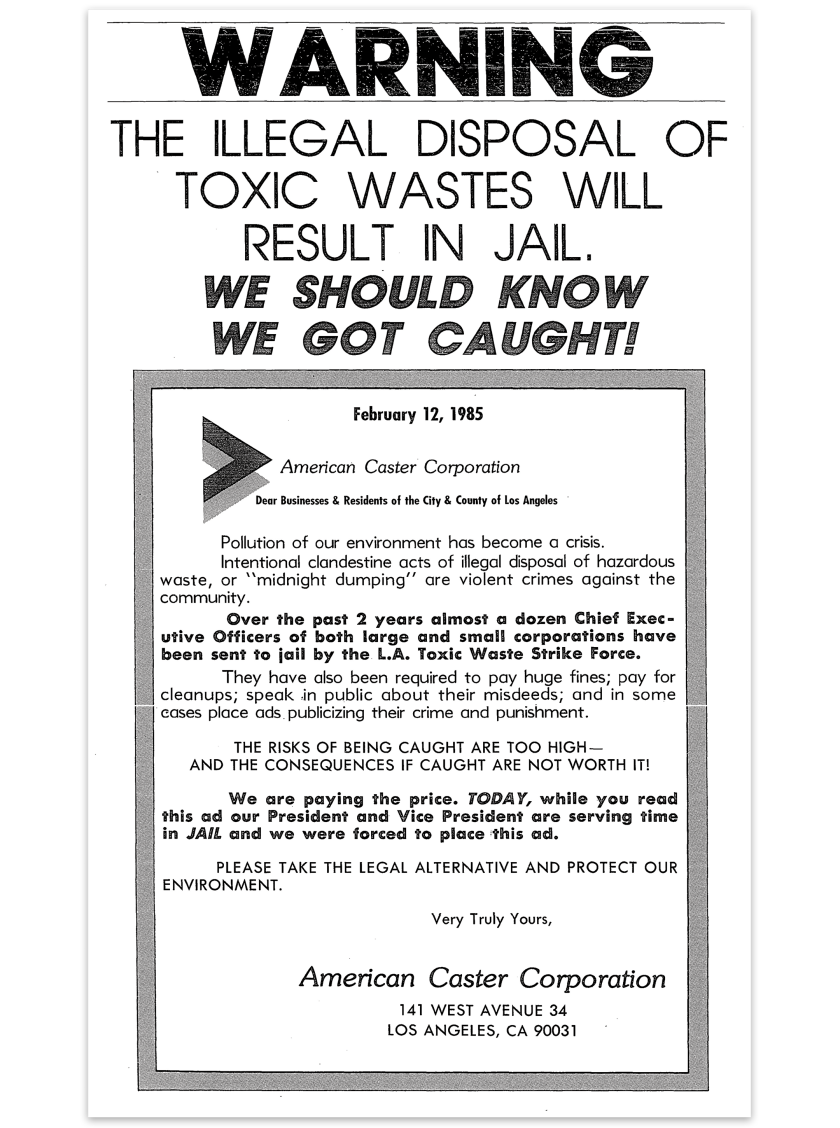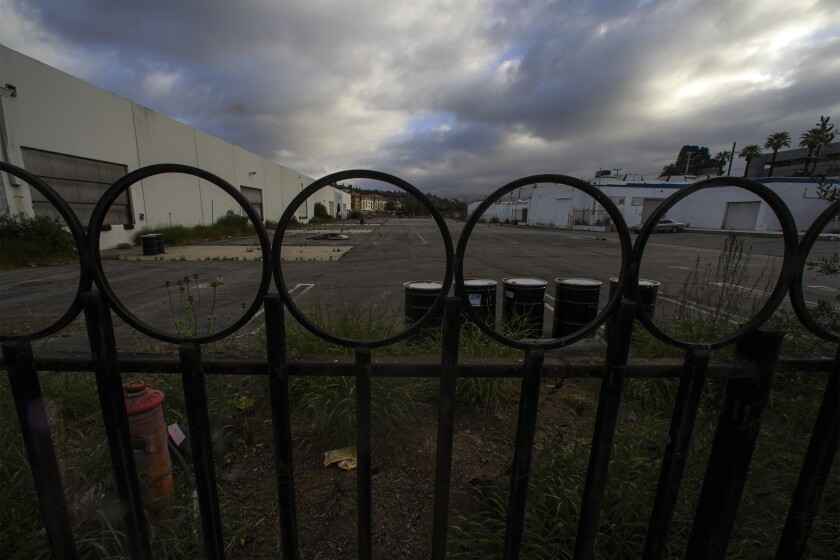A long-forgotten harmful dump website is boosting new problems for this Los Angeles neighborhood
In the summer months of 1984, investigators peered into a cave dug beneath the Lincoln Heights neighborhood of Los Angeles and observed dozens of rusted 55-gallon barrels crammed with poisonous substances.
Some of the barrels lay nearly empty soon after their contents experienced leaked via corroded metal and escaped into the soil.
“I observed the hole and I reported, ‘I can’t think it — who would do one thing like this?’,’’ recalled Barry Groveman, the head of the now-defunct Los Angeles Hazardous Squander Task Pressure. At the time, he described the dump as “a violent crime towards the group.”
Groveman and his investigators went on to uncover 252 barrels buried in identical caverns surrounding a producing warehouse at 141 West Avenue 34, in which the American Caster Corp. operated. Some of the chemicals ended up also dumped into sewer lines. Ahead of the discovery, the dumping follow experienced carried on for four yrs.
Soon after a hasty cleanup, and as the company’s executives and quite a few workers served six months in jail and paid out countless numbers of bucks in fines, investigators moved on to other instances. The court records were sooner or later wrecked — widespread for outdated municipal paperwork — and the situation largely faded from memory.
Now, virtually 40 years later on, environmental considerations at the Avenue 34 website have the moment yet again shaken the community as genuine estate developers want to demolish the industrial warehouse and, in its position, make a 5-story apartment complex, retail area and an underground parking garage.
Lourdes Garcia and her 8-yr-previous son, Enzio Parra, on their way to Hillside Elementary University. At an deserted industrial warehouse on Avenue 34, a developer wishes to establish a 5-tale condominium intricate.
(Irfan Khan / Los Angeles Periods)
Right until just lately, local community activists had opposed the task due to the fact they said it would gentrify their predominantly operating-class, Latino and Asian community. They also apprehensive that contamination from a neighboring dry cleaner could be disturbed through construction and leave them susceptible to publicity.
Though regulators considered the former dry cleaner internet site to be unfit for household development, because of to lingering chemicals beneath the floor, the condition authorized developers to develop housing on the neighboring Avenue 34 website.
But when a group member not long ago arrived throughout archived Los Angeles Periods content articles highlighting the 1984 circumstance, the revelation shocked inhabitants. They are now accusing California regulators of failing to effectively test the a long time-old dumpsite and encompassing homes, and are contacting for a new cleanup strategy.

In December 2021, Sara Clendening, president of the Lincoln Heights Community Council, dug up this Los Angeles Situations short article from 1984, revealing a concealed layer of the Avenue 34 progress site’s history. (Click on impression above to see a pdf.)
Community activists Patricia Camacho and Michael Hayden, who the two reside across the road from the proposed housing development, be concerned that illegally dumped chemical compounds may possibly have migrated to other parts.
“Toxins never end at residence lines,” Camacho mentioned. “It’s just so disappointing that the cleanup system did not include things like screening outside of the assets. Individuals of us who live 30 feet from where by this is going on, we feel like we are not remaining shielded.”
When challenge developer R Cap Avenue 34, LLC sought acceptance from the town and point out to build in 2020, the group insisted the Avenue 34 web-site experienced minor to no contamination and chemicals were confined to the dry cleaning internet site.

A college bus on Pasadena Avenue in a neighborhood the place a developer needs to establish a five-tale apartment elaborate on what is now an deserted industrial warehouse.
(Irfan Khan / Los Angeles Occasions)
Nevertheless, screening completed at the house in late 2021 discovered amounts of unstable natural compounds, or VOCs, that were being extra than 4,000 periods higher than what is advised for residential expectations. The compounds involved the dry cleaning solvent tetrachloroethylene, or PCE, which the Centers for Sickness Regulate and Prevention suggests may well hurt the nervous technique, reproductive system, liver and kidneys, and could quite possibly lead to cancer.
In spite of group protests, reignited by discovery of the 1984 situation, the developer’s program to eliminate chemical waste from the internet site was approved by the state’s Department of Toxic Substances Manage, which has overseen cleanup at the laundry web page. The company declared that “nearby citizens, organizations, and universities are safe from contaminants found at the Web site,” and in its determination, added that “there is no important danger further than the assets boundaries.”
The office stated the 1984 case has no influence on the cleanup of the web page.
“Most responsible parties want to make sure when they produce a house there will not be lingering concerns or exposure that could damage long run people, or persons close by — that’s not the case in this article,” reported Angelo Bellomo, previous head of environmental wellness for the Los Angeles County Section of Community Health and a previous DTSC formal who has been significant of the project’s cleanup prepare. “How could this get help from town council, area regulatory organizations and the condition regulatory company?”

The American Caster Corp., which operated at the Avenue 34 internet site, was compelled to obtain a total-web page advertisement in the L.A. Instances soon after becoming convicted of burying and dumping poisonous squander in Lincoln Heights. “The whole goal of it was deterrence,” reported Barry Groveman, an lawyer who prosecuted the 1984 situation. (Simply click impression higher than to check out a pdf.)
Currently, hulking and deserted warehouses span most of the improvement web-site. Feather reed grass and weeds sprout from cracked asphalt and obscure partitions. DTSC function notices saying previous year’s tests are zip-tied to fences, when an abandoned protection patrol automobile with a toppled business chair on its roof sits beside a large pile of sandbags and steel barrels.
“I used every day in 2012 and 2013 on that web-site, and we had no strategy it was contaminated and poisonous,” reported Fernanda Sanchez, who in superior school took kickboxing lessons at a gymnasium that after operated at Avenue 34.
Born and lifted in Lincoln Heights, she joined endeavours in 2020 to notify her neighbors of the new growth, which together with the threat of contamination, she feared would push up residence values and value out recent inhabitants. Previous year, she was elected to the community council.
“It’s just a type of environmental racism,” Sanchez claimed. “Our minimal-profits, immigrant communities are not noticed as precious, no matter whether it’s displacing us or poisoning us — they totally disregard our human rights.”
Developers hope to change the deserted property into “a healthier and vivid community” with community open area within just walking length to two Metro Gold Line stations. The challenge promises 468 apartment units, most at industry amount, with a compact portion, 66 models, set apart as affordable housing.
“We will soon start out the course of action of a site cleanup that was authorized by and will be carried out below the supervision of the Condition Department of Poisonous Substances Regulate,” the advancement team said in a statement. “As was constantly required by the Avenue 34 project’s entitlement approvals from the Metropolis of Los Angeles, the website has undergone extensive environmental review, assessment, and tests.”

Mother and father fall their children off at Hillside Elementary, situated on Avenue 35, incredibly shut to an abandoned industrial web site on 141 W. Avenue 34 in Lincoln Heights.
(Irfan Khan / Los Angeles Instances)
The demolition of warehouse structures and the cleanup of soils is scheduled to commence in early Might and will continue for various months.
Jane Williams, govt director of California Communities Versus Toxics, who has voiced concerns about the undertaking due to the fact very last yr, also questioned why the state did not carry out extra testing following the group uncovered the 1984 circumstance.
Williams and many others say they are concerned about the presence of VOCs in soils beneath the advancement web page. These usually odorless compounds might enter properties by means of cracks, home windows or utility strains in a phenomenon acknowledged as vapor intrusion.
To safeguard towards vapor intrusion, specialists are properly trained to monitor how far chemicals have traveled beneath the ground ahead of eliminating them from the soil.
“We generally look extremely very carefully at a web-site that is getting created and question, ‘Are we defending towards this phenomenon of vapor intrusion?’” explained James Wells, an environmental geologist who was an advisor to the point out in the course of its cleanup of the Exide battery recycling plant in Vernon and has not long ago been advising Lincoln Heights citizens. “At this web page, I did not sense like the [cleanup plan] achieved that conventional.”
Point out regulators keep on to guarantee the community that risky chemical compounds on the home have not distribute to nearby residences.
Wells, nonetheless, claimed these types of a conclusion was untimely, given the rediscovery of the 1984 chemical dump.
Wells and Bellomo are calling on regulators and builders to pause demolition and carry out far more tests. They also want regulators to carry out a whole investigation into the character of the illegal dumping as perfectly as how the chemicals were being cleaned up.
Accurately how deep DTSC seemed into the 1984 scenario before approving the developer’s cleanup program remains unclear. However, Groveman, the head prosecutor in the 1984 case, stated DTSC contacted and interviewed him in early April, which was quite a few months soon after the department had by now adopted the cleanup strategy.
In the days considering that then, DTSC confirmed that it has looked at county and condition documents and could not find any paperwork that present the place of the buried barrels or how they ended up cleaned up.
Neither the cleanup prepare nor DTSC’s summary in the state’s Envirostor databases — an on line supply exactly where officers retail outlet documents of contaminated homes — make any mention of the 1984 situation.
“This is a massive location of uncertainty. How could we not want to fill that hole of uncertainty, supplied that this is a type of infamous web-site again in the ‘80s,” Wells mentioned. “The cleanup standards were being practically nothing like they had been these days.”
Javier Hinojosa, a DTSC formal who is working on the testing and cleanup at Avenue 34, reported he agrees cleanup standards had been not what they had been 40 years ago. On the other hand, he stood by the department’s screening at the website, which also looked for the chemicals uncovered in the 1980s case.
“There need to be some self esteem in the details and that we’re going to do the cleanup,” Hinojosa stated.

A steel gate blocks the entrance to a advanced of an deserted industrial warehouse.
(Irfan Khan / Los Angeles Periods)
It remains to be noticed whether the recently revived issues about the 1984 dumping circumstance will hold off advancement of the web site. Nevertheless, even in December, general public officials like Los Angeles County Supervisor Hilda Solis and U.S. Rep. Jimmy Gomez (D-Los Angeles) have reported approval of the cleanup strategy was untimely and far more testing need to be completed. The U.S. Environmental Security Agency has also met with DTSC officials in December and expressed problem that their screening criteria were being a lot less stringent than federally-advised requirements for residential developments.
In the meantime, longtime citizens like Cesar Salazar, 72, reported the speed of growth in northeast Los Angeles was expanding.
Salazar recalled a string of developments that resulted in the eviction of inhabitants to make way for new housing initiatives. Even so, he mentioned he was amazed to learn of the most current project, given the site’s heritage of harmful squander.
Salazar remembered a long time in the past in the 1980s, looking at bulldozers bore trenches into the soil near warehouses on Avenue 34 and as personnel hauled canisters of chemical compounds, tossing them into the holes like coffins of a mass grave. The smell, he recalled, was foul, equivalent to the stink of automobile grease.
“I was incredibly surprised they ended up so daring and blatant,” Salazar mentioned. “They didn’t even wait for the sun to go down.”





